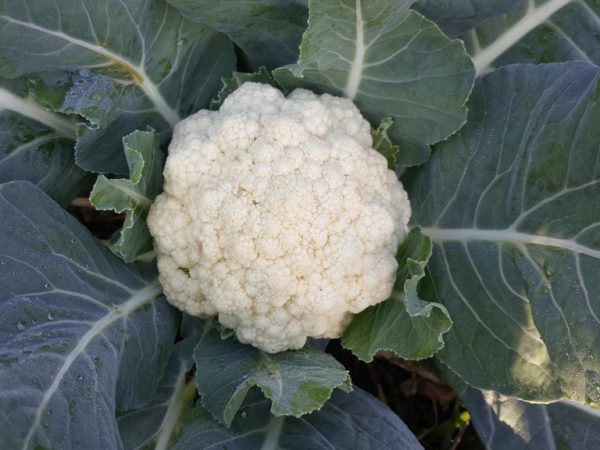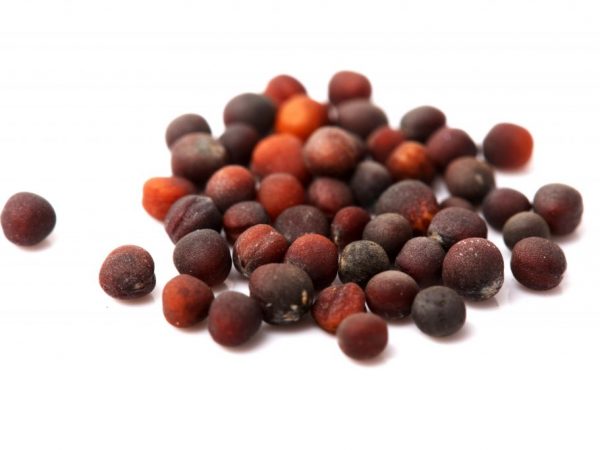Description of cauliflower Snowball 123
Cauliflower Snowball 123 is a popular mid-early variety used in Russia. The main thing in growing is to adhere to a clear watering schedule. In terms of demanding soil composition, fertilizing and moisture, it surpasses other known varieties of cabbage.

Description of cauliflower Snowball 123
Characteristics of the variety
Cauliflower Snowball 123 was bred by French scientists as a result of breeding work. It grows in all countries of Western Europe. The variety has taken root well in all regions of the country.
From the moment the first sprouts appear to technical maturation, 80-110 days pass, depending on climatic conditions. From 1 sq. m harvest from 2 to 4 kg. Cauliflower Snowball 123 contains a large amount of phytoncides, antioxidants and minerals necessary for the functioning of the human body.
Description of culture
Description of Snowball Cabbage:
- the deciduous part is raised, colored bluish-green;
- heads are large, snow-white, weighing 0.4-1 kg;
- the fruit is covered with foliage, does not turn yellow.
The variety has good taste, it is kept fresh for a long time, it is suitable for freezing with further processing in winter and for the preparation of any culinary dishes, retains its density even after heat treatment.
The main advantage of Snowball cauliflower is its high yield. Growth features free the gardener from the need to pinch the upper leaves. The head of cabbage framed by foliage is completely protected from negative external influences.
Growing rules
A thermophilic plant, the Snowball 123 cabbage, needs protection from frost. Cultivation is carried out in seedlings. Seedlings are grown in a bright cool room.
A glazed balcony, veranda or unheated greenhouse will do. When grown in an apartment, on the windowsill, the sprouts will be weak, too high, which will not allow it to adapt in the open field after a pick. Before taking on the cultivation of the Snowball cabbage variety, they find a worthy place for it on the site. Cauliflower tastes well fertilized loamy soil with a neutral alkaline balance in the range of 6.5-7. It is better to give preference to an open area, protected from drafts, into which the sun's rays fall unhindered.
They begin to dig up the soil in the fall, after harvesting, then fertilize is applied. With increased acidity, liming is carried out 2 weeks after fertilization. In the spring, the soil is loosened superficially. A dense soil consistency is required to produce good, strong inflorescences.
Planting seedlings

Seeds need to be hardened
The seeds are pre-soaked in a disinfectant solution of manganese or Fitosporin and then tempered by placing them for 24 hours on an environment where the temperature will not exceed 5 ℃. The ideal option is to plant each seed in a separate container.The root system of plants is weak, superficial and does not tolerate picking well. It is permissible to use peat pots or plastic cups.
The soil mixture should be nutritious, well loosened. Sowing seeds is carried out in depressions no more than 0.5 cm. 2-3 seeds are sown in one container at the beginning of April. The pots are covered with foil to create a greenhouse effect. After the emergence of seedlings, thinning is not carried out so as not to damage the root system. When 2-3 strong leaves appear, top dressing is carried out with dissolved urea.
Watering is carried out based on the condition of the soil. It should be kept moist at all times. Hardening of seedlings is carried out from the moment 5 true leaves appear. The sprouts are transferred to a cooler place, gradually accustoming them to open air. It takes about a week to harden, after which the plants dive into the prepared area.
Open ground dive
Snowball 123 cauliflower is transplanted into open ground in May. Do not plant the sprouts too close, otherwise the yield will decrease. The optimal step between the bushes is 50 cm, between the rows - 70 cm.
You need to deepen the plants before the first leaves appear. The soil is preliminarily treated with karbofos in order to prevent the spread of the bear. After the pick, each plant is watered and covered with cut plastic bottles.
Care
Growing cauliflower is a complex process. To get a good harvest, the plants are properly cared for. The optimum temperature for Snowball 123 is between 10-25 ℃. The decrease in temperature is controlled by installing shelters, the increase is by frequent watering and a refreshing shower for the foliage. Under normal conditions, watering is carried out every 3 days under the root with warm water.
After moistening, the soil is mulched. As top dressing, infusions of green grass with mullein are suitable. Be sure to apply fertilizers with boron and molybdenum in the composition. You can use a vitamin B1 solution available from a pharmacy. Fertilizers with nitrogen-containing compositions are stopped when an ovary appears. Next, spraying is carried out with the following composition:
- 10 liters of water;
- 1 g of boric acid;
- 1 tsp potassium magnesium;
- 1 tbsp. l. superphosphate.
Diseases and pests
Deciduous rosette is raised above ground level, fungal diseases of this vegetable crop are not terrible. She is overcome by cabbage flies, aphids, scoops, slugs. To protect against flying pests, spraying with a weakly acidic vinegar solution is periodically carried out.
After watering, the soil is loosened and sprinkled with wood ash. Then slugs are not able to feast on vegetables. Another option is to plant flowers around the beds, which, with their smell, will interrupt the scent of cabbage. The main preventive method is pre-treatment of seeds before planting and high-quality loosening of the soil after watering.
Conclusion
Growing Snowball 123 cabbage is a hassle, but worth it. The main thing is to provide the plant with proper care. They try to create conditions in which the root system of the seedlings will be damaged to a minimum. Also, cauliflower does not like picking.
Before diving into the ground, the beds are fertilized so that the plants can quickly adapt to new conditions. Do not forget about high-quality watering and shelters, the procedure for hardening seeds and seedlings.


